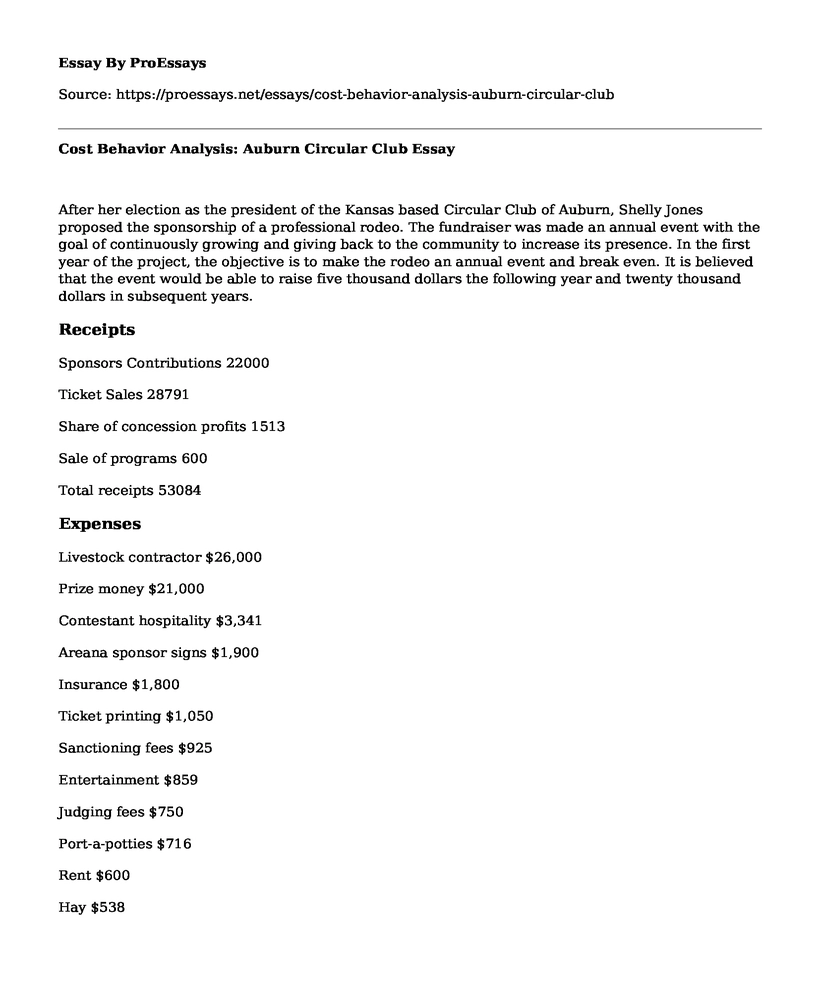After her election as the president of the Kansas based Circular Club of Auburn, Shelly Jones proposed the sponsorship of a professional rodeo. The fundraiser was made an annual event with the goal of continuously growing and giving back to the community to increase its presence. In the first year of the project, the objective is to make the rodeo an annual event and break even. It is believed that the event would be able to raise five thousand dollars the following year and twenty thousand dollars in subsequent years.
Receipts
Sponsors Contributions 22000
Ticket Sales 28791
Share of concession profits 1513
Sale of programs 600
Total receipts 53084
Expenses
Livestock contractor $26,000
Prize money $21,000
Contestant hospitality $3,341
Areana sponsor signs $1,900
Insurance $1,800
Ticket printing $1,050
Sanctioning fees $925
Entertainment $859
Judging fees $750
Port-a-potties $716
Rent $600
Hay $538
Programs $500
500 Western Hats $450
Hotel rooms $325
Utilities $300
Sand $251
Miscellaneous fixed costs $105
Total expenses $61,410
Breakeven Point = Variable Cost / Contribution Margin (Everingham et al., 2007)
Fixed Costs = $51,000
Variable Costs = 4% of $53,084
Variable Costs = $2,123.36
Contribution Margin = 100% - 4% = 0.96 (United States, 2014).
Therefore, breakeven point = $51,000/0.96
Breakeven Point = $53,125
To get the level of sales needed for Circular Club of Auburn to breakeven, the fund collected from sponsors is subtracted from the previous breakeven point, which was $53,125.
Breakeven Point of Ticket Sales = $53,125 - $25,600
Breakeven Point = $27,525
The breakeven point is a commonly used concept of economic and financial analysis. It is used not only by economists, but also by financial planners, and managers in the management of financial resources. Break-even point represents the sales level, either revenue or units, required to cover overall costs, which comprises of both fixed and variable costs (Everingham et al., 2007). At the breakeven point, the profit gained is zero and it is only possible to break even when the sales value is greater than the per unit variable cost. It implies that the sales value of a commodity must be high enough to meet the costs a company used in producing it. Once the sales surpass the production cost, the company can start enjoying its profits.
Breakeven parameter is used allows the members of the organization to identify the necessary outputs and set their goals towards meeting them. The value is the breakeven point is not generic and varies based on a given situation. The figure allows the organization to understand its sales targets and how it can start making profits. The benefit the contribution of each sale to the payment of variable and fixed costs is clearly depicted when computing breakeven point (the United States, 2014). When the organization cannot generate ticket sales equivalent to the breakeven point, then it will be a feasible venture. It should consider popularizing the event further within the community to generate sales significant enough to cover fixed costs. When the Club considers that such sales level is not feasible, it can consider reducing fixed costs through better management of expenses and rent reduction, among other alternatives. Similarly, the organization can lower variable costs, which can be through sourcing new suppliers for cheap direct inputs. All these alternatives can lower breakeven point and hence the Club need not issue any more tickets to meet fixed costs. The objective of the breakeven point to establish the least output that needs to be exceeded for an enterprise to generate a profit.
References
Everingham, G. K., Kleynhans, J. E., & Posthumus, L. C. (2007). Principles of GAAP. Cape Town, South Africa: Juta.
United States. (2014). U.S. Securities and Exchange Commission. Washington, D.C: U.S. Securities and Exchange Commission.
Cite this page
Cost Behavior Analysis: Auburn Circular Club. (2022, Apr 04). Retrieved from https://proessays.net/essays/cost-behavior-analysis-auburn-circular-club
If you are the original author of this essay and no longer wish to have it published on the ProEssays website, please click below to request its removal:
- Essay Example: Taxes Are Significant for the General Development of a Nation
- Momentum Investment Paper Example
- Essay Sample on Usefulness of Accounting Information to Investment Analysts
- T-Mobile Financial Statement Analysis
- Essay on Governor Introduces Budget Cuts: Evaluating Areas for Financial Cut Down
- Essay Sample on Managed Care Redefines Health Insurance: Eliminating Generalization by Practitioners
- Essay Example on Creating Financial Stability: A Short-Term Action Plan







